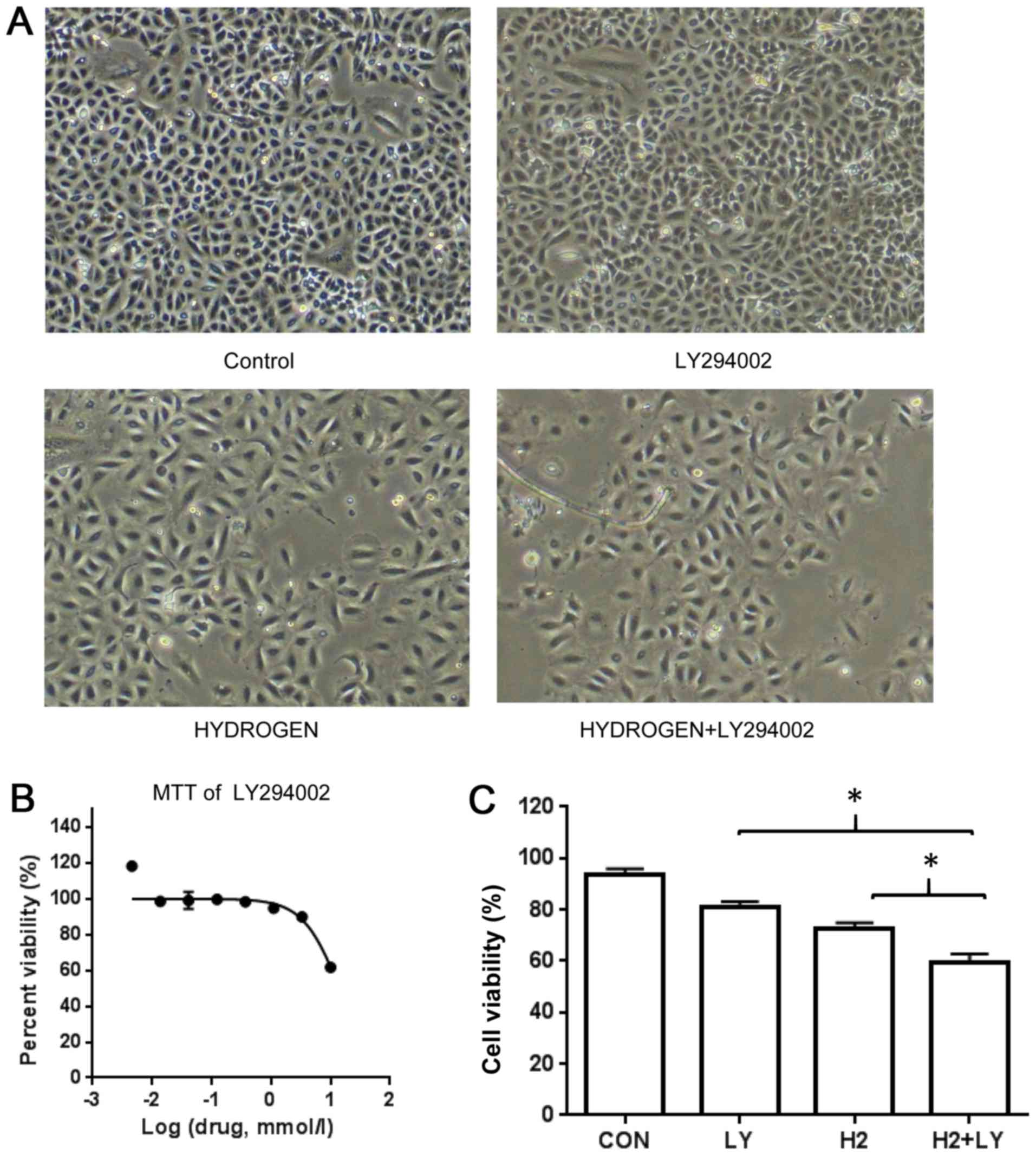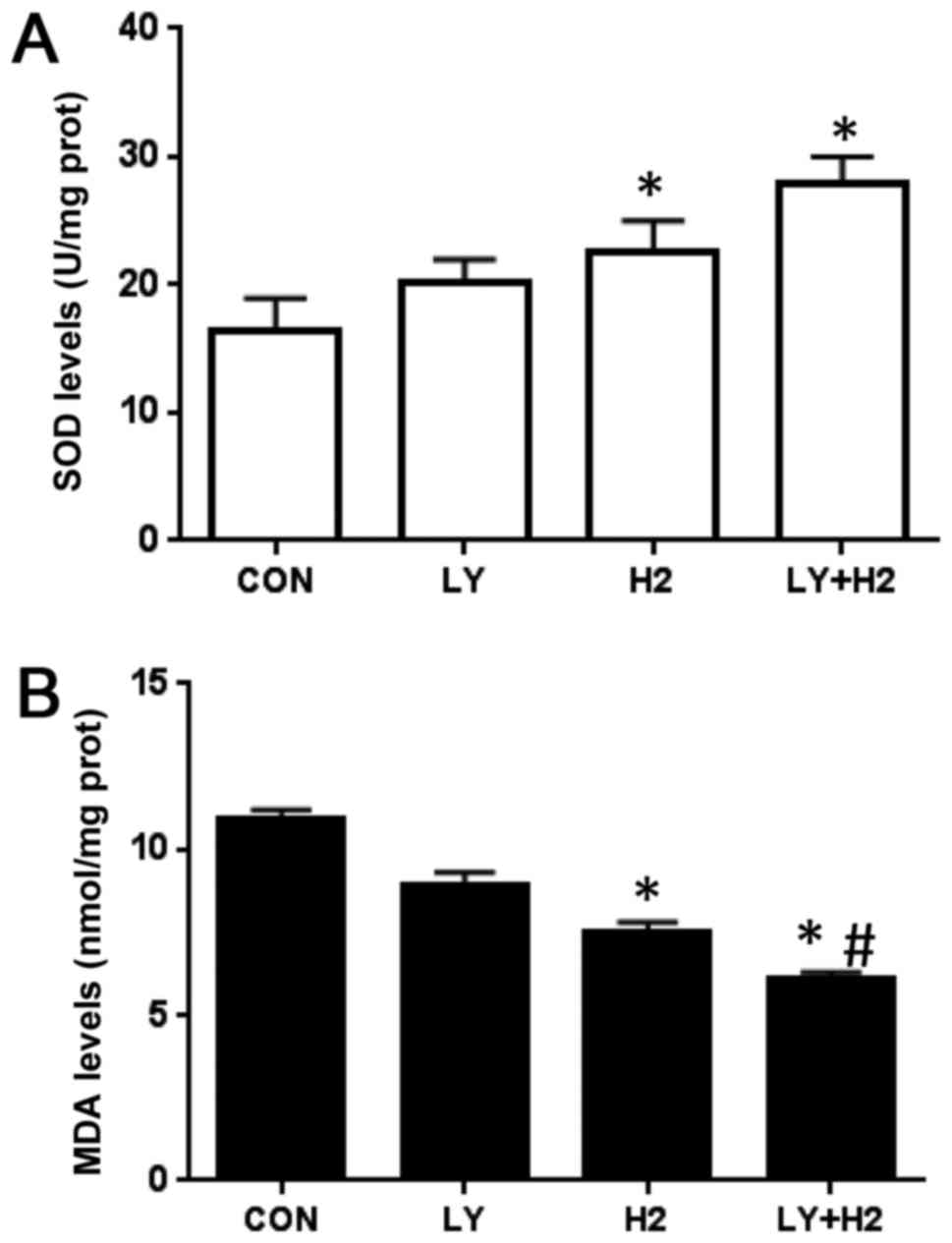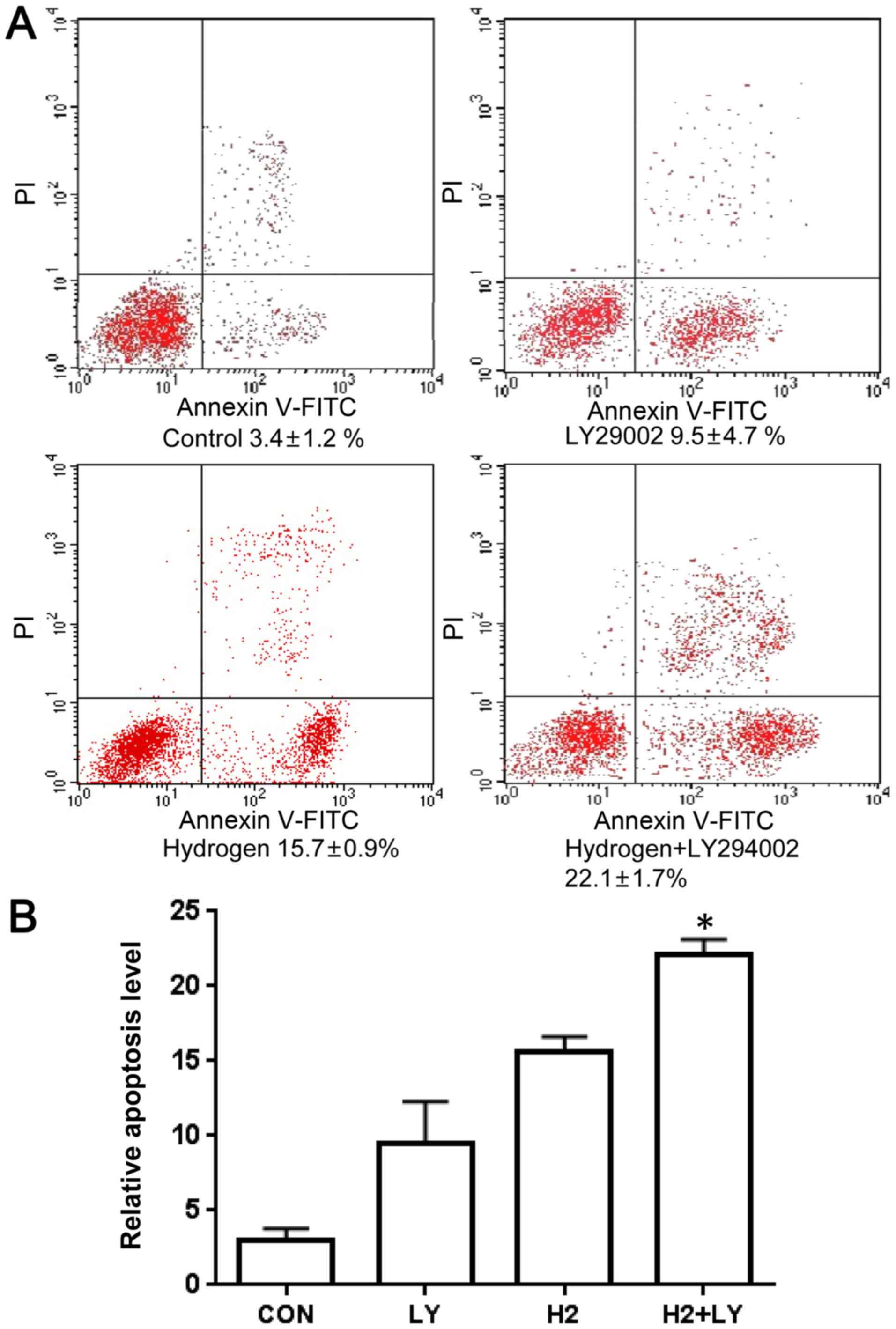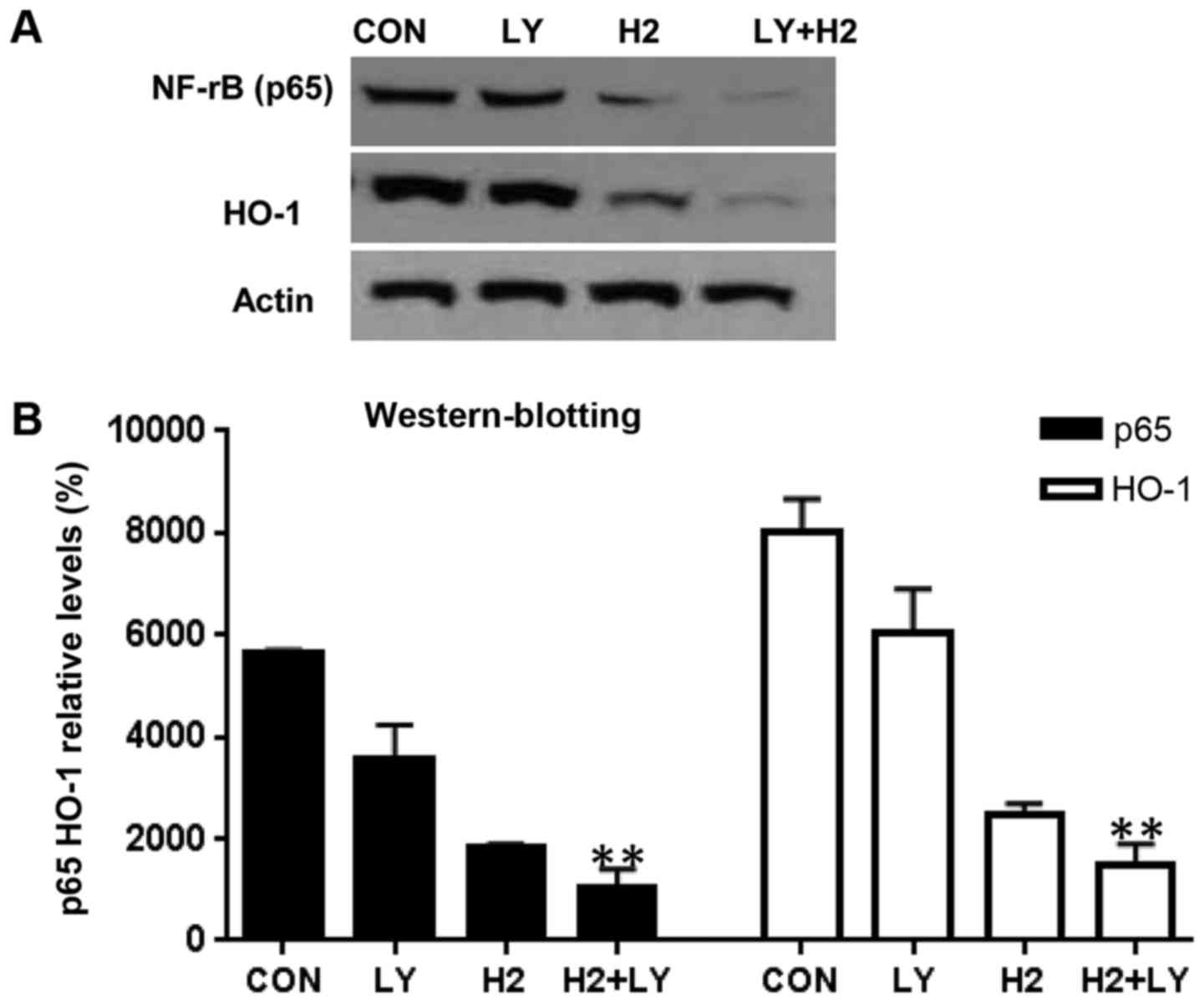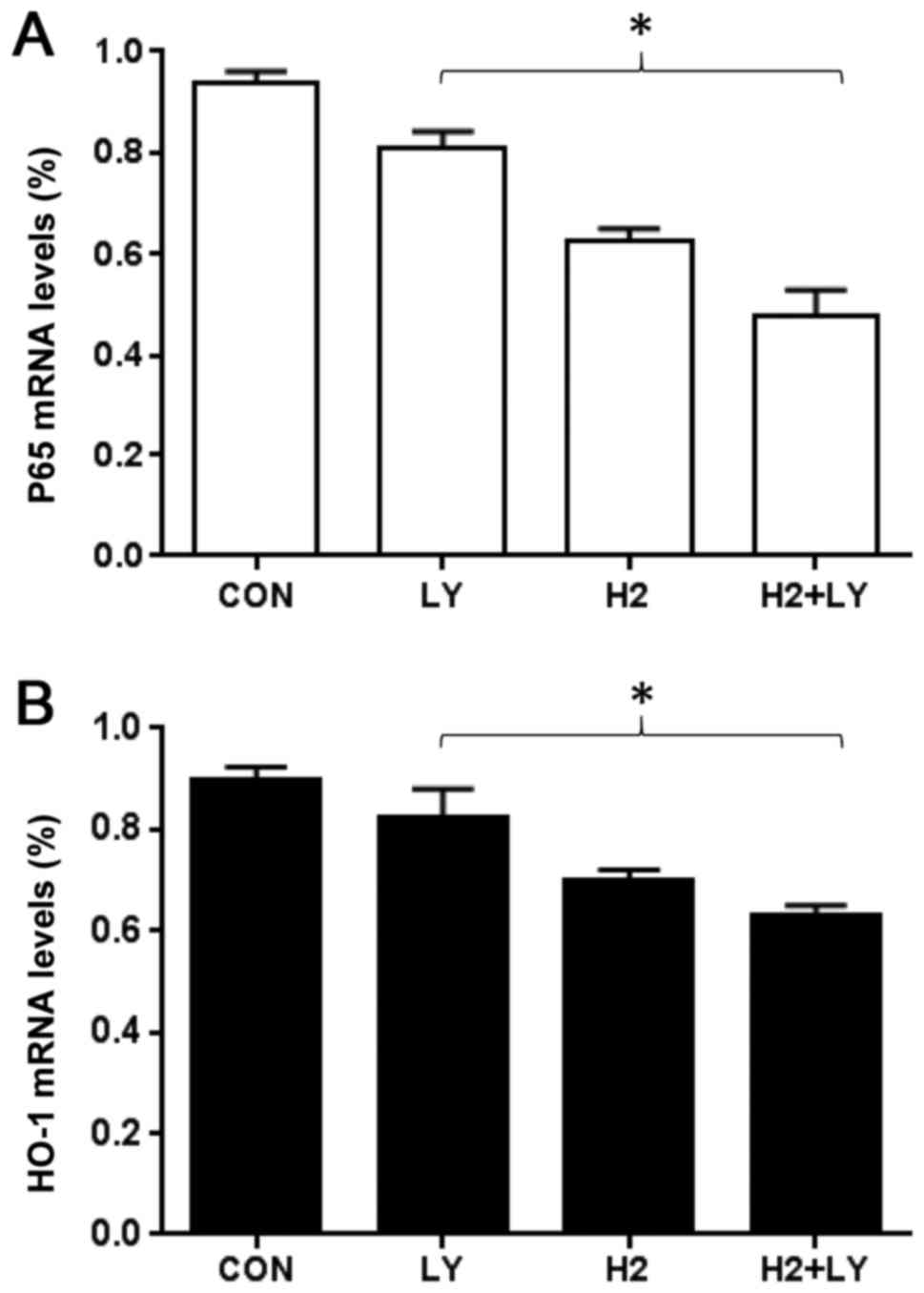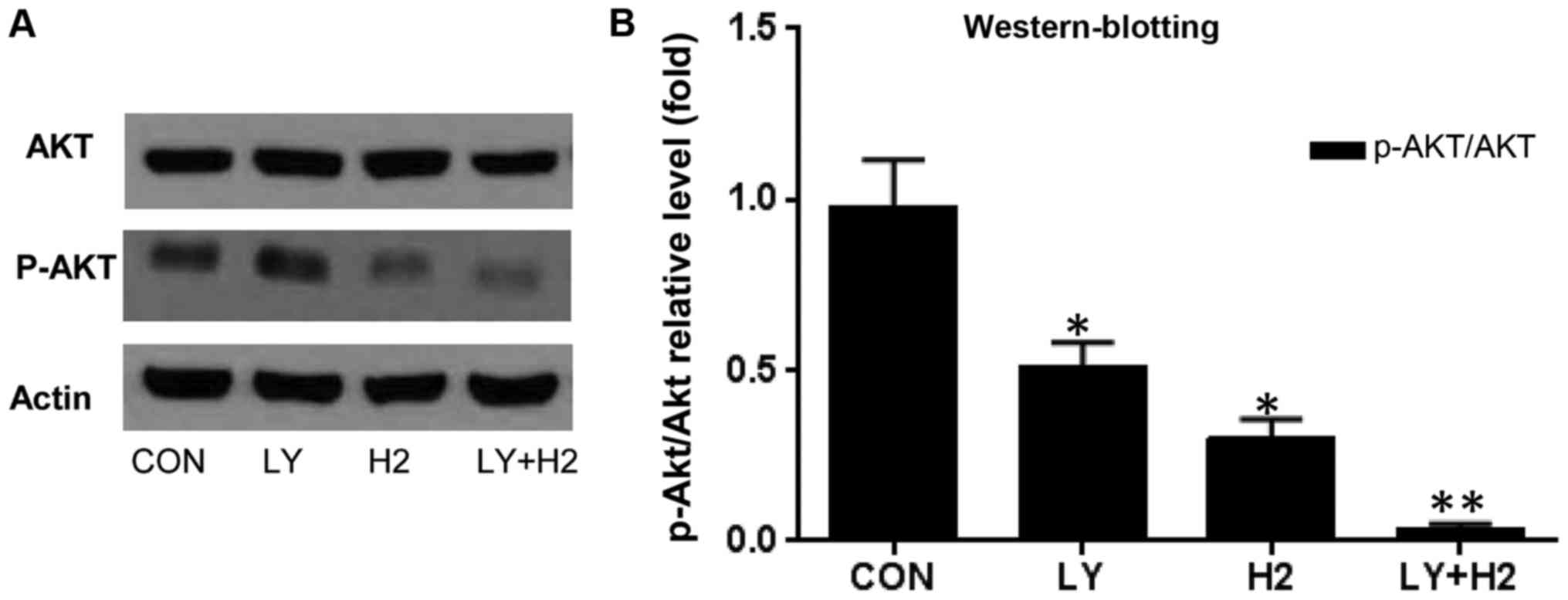|
1
|
Siegel RL, Miller KD and Jemal A: Cancer
statistics, 2017. CA Cancer J Clin. 67:7–30. 2017. View Article : Google Scholar : PubMed/NCBI
|
|
2
|
Chen W, Zheng R, Baade PD, Zhang S, Zeng
H, Bray F, Jemal A, Yu XQ and He J: Cancer statistics in China,
2015. CA Cancer J Clin. 66:115–132. 2016. View Article : Google Scholar : PubMed/NCBI
|
|
3
|
Jemal A, Siegel R, Ward E, Murray T, Xu J
and Thun MJ: Cancer statistics, 2007. CA Cancer J Clin. 57:43–66.
2007. View Article : Google Scholar : PubMed/NCBI
|
|
4
|
Yan Z, Dai Y, Fu H, Zheng Y, Bao D, Yin Y,
Chen Q, Nie X, Hao Q, Hou D and Cui Y: Curcumin exerts a protective
effect against premature ovarian failure in mice. J Mol Endocrinol.
60:261–271. 2018. View Article : Google Scholar : PubMed/NCBI
|
|
5
|
Duracková Z: Some current insights into
oxidative stress. Physiol Res. 59:459–469. 2010.PubMed/NCBI
|
|
6
|
Reuter S, Gupta SC, Chaturvedi MM and
Aggarwal BB: Oxidative stress, inflammation, and cancer: How are
they linked? Free Radic Biol Med. 49:1603–1616. 2010. View Article : Google Scholar : PubMed/NCBI
|
|
7
|
Visconti R and Grieco D: New insights on
oxidative stress in cancer. Curr Opin Drug Discov Devel.
12:240–245. 2009.PubMed/NCBI
|
|
8
|
Kinnula VL and Crapo JD: Superoxide
dismutases in the lung and human lung diseases. Am J Respir Crit
Care Med. 167:1600–1619. 2003. View Article : Google Scholar : PubMed/NCBI
|
|
9
|
Esme H, Cemek M, Sezer M, Saglam H, Demir
A, Melek H and Unlu M: High levels of oxidative stress in patients
with advanced lung cancer. Respirology. 13:112–116. 2008.
View Article : Google Scholar : PubMed/NCBI
|
|
10
|
Valavanidis A, Vlachogianni T, Fiotakis K
and Loridas S: Pulmonary oxidative stress, inflammation and cancer:
Respirable particulate matter, fibrous dusts and ozone as major
causes of lung carcinogenesis through reactive oxygen species
mechanisms. Int J Environ Res Public Health. 10:3886–3907. 2013.
View Article : Google Scholar : PubMed/NCBI
|
|
11
|
Møller P, Folkmann JK, Forchhammer L,
Bräuner EV, Danielsen PH, Risom L and Loft S: Air pollution,
oxidative damage to DNA, and carcinogenesis. Cancer Lett.
266:84–97. 2008. View Article : Google Scholar : PubMed/NCBI
|
|
12
|
Hawthorn L, Stein L, Panzarella J, Loewen
GM and Baumann H: Characterization of cell-type specific profiles
in tissues and isolated cells from squamous cell carcinomas of the
lung. Lung Cancer. 53:129–142. 2006. View Article : Google Scholar : PubMed/NCBI
|
|
13
|
Azad N, Rojanasakul Y and Vallyathan V:
Inflammation and lung cancer: Roles of reactive oxygen/nitrogen
species. J Toxicol Environ Health B Crit Rev. 11:1–15. 2008.
View Article : Google Scholar : PubMed/NCBI
|
|
14
|
Dillon RL, White DE and Muller WJ: The
phosphatidyl inositol 3-kinase signaling network: Implications for
human breast cancer. Oncogene. 26:1338–1345. 2007. View Article : Google Scholar : PubMed/NCBI
|
|
15
|
Gustafson AM, Soldi R, Anderlind C,
Scholand MB, Qian J, Zhang X, Cooper K, Walker D, McWilliams A, Liu
G, et al: Airway PI3K pathway activation is an early and reversible
event in lung cancer development. Sci Transl Med. 2:26ra252010.
View Article : Google Scholar : PubMed/NCBI
|
|
16
|
Fry MJ: Phosphoinositide 3-kinase
signalling in breast cancer: How big a role might it play? Breast
Cancer Res. 3:304–312. 2001. View
Article : Google Scholar : PubMed/NCBI
|
|
17
|
Martelli AM, Evangelisti C, Chappell W,
Abrams SL, Bäsecke J, Stivala F, Donia M, Fagone P, Nicoletti F,
Libra M, et al: Targeting the translational apparatus to improve
leukemia therapy: Roles of the PI3K/PTEN/Akt/mTOR pathway.
Leukemia. 25:1064–1079. 2011. View Article : Google Scholar : PubMed/NCBI
|
|
18
|
Davies MA: The role of the PI3K-AKT
pathway in melanoma. Cancer J. 18:142–147. 2012. View Article : Google Scholar : PubMed/NCBI
|
|
19
|
Chang F, Lee JT, Navolanic PM, Steelman
LS, Shelton JG, Blalock WL, Franklin RA and McCubrey JA:
Involvement of PI3K/Akt pathway in cell cycle progression,
apoptosis, and neoplastic transformation: A target for cancer
chemotherapy. Leukemia. 17:590–603. 2003. View Article : Google Scholar : PubMed/NCBI
|
|
20
|
Wong KK, Engelman JA and Cantley LC:
Targeting the PI3K signaling pathway in cancer. Curr Opin Genet
Dev. 20:87–90. 2010. View Article : Google Scholar : PubMed/NCBI
|
|
21
|
Nakao A, Toyoda Y, Sharma P, Evans M and
Guthrie N: Effectiveness of hydrogen rich water on antioxidant
status of subjects with potential metabolic syndrome-an open label
pilot study. J Clin Biochem Nutr. 46:140–149. 2010. View Article : Google Scholar : PubMed/NCBI
|
|
22
|
Ohsawa I, Ishikawa M, Takahashi K,
Watanabe M, Nishimaki K, Yamagata K, Katsura K, Katayama Y, Asoh S
and Ohta S: Hydrogen acts as a therapeutic antioxidant by
selectively reducing cytotoxic oxygen radicals. Nat Med.
13:688–694. 2007. View
Article : Google Scholar : PubMed/NCBI
|
|
23
|
Buchholz BM, Kaczorowski DJ, Sugimoto R,
Yang R, Wang Y, Billiar TR, McCurry KR, Bauer AJ and Nakao A:
Hydrogen inhalation ameliorates oxidative stress in transplantation
induced intestinal graft injury. Am J Transplant. 8:2015–2024.
2008. View Article : Google Scholar : PubMed/NCBI
|
|
24
|
Ohta S: Molecular hydrogen is a novel
antioxidant to efficiently reduce oxidative stress with potential
for the improvement of mitochondrial diseases. Biochim Biophys
Acta. 1820:586–594. 2012. View Article : Google Scholar : PubMed/NCBI
|
|
25
|
Takaki A, Kawai D and Yamamoto K: Multiple
hits, including oxidative stress, as pathogenesis and treatment
target in non-alcoholic steatohepatitis (NASH). Int J Mol Sci.
14:20704–20728. 2013. View Article : Google Scholar : PubMed/NCBI
|
|
26
|
Fukuda K, Asoh S, Ishikawa M, Yamamoto Y,
Ohsawa I and Ohta S: Inhalation of hydrogen gas suppresses hepatic
injury caused by ischemia/reperfusion through reducing oxidative
stress. Biochem Biophys Res Commun. 361:670–674. 2007. View Article : Google Scholar : PubMed/NCBI
|
|
27
|
Chou TC: Theoretical basis, experimental
design, and computerized simulation of synergism and antagonism in
drug combination studies. Pharmacol Rev. 58:621–681. 2006.
View Article : Google Scholar : PubMed/NCBI
|
|
28
|
Desai UN, Shah KP, Mirza SH, Panchal DK,
Parikh SK and Rawal RM: Enhancement of the cytotoxic effects of
Cytarabine in synergism with Hesperidine and Silibinin in Acute
Myeloid Leukemia: An in-vitro approach. J Cancer Res Ther.
11:352–357. 2015. View Article : Google Scholar : PubMed/NCBI
|
|
29
|
Livak KJ and Schmittgen TD: Analysis of
relative gene expression data using real-time quantitative PCR and
the 2(-Delta Delta C(T)) method. Methods. 25:402–408. 2001.
View Article : Google Scholar : PubMed/NCBI
|
|
30
|
Barreiro E, Fermoselle C, Mateu-Jimenez M,
Sánchez-Font A, Pijuan L, Gea J and Curull V: Oxidative stress and
inflammation in the normal airways and blood of patients with lung
cancer and COPD. Free Radic Biol Med. 65:859–871. 2013. View Article : Google Scholar : PubMed/NCBI
|
|
31
|
Khansari N, Shakiba Y and Mahmoudi M:
Chronic inflammation and oxidative stress as a major cause of
age-related diseases and cancer. Recent Pat Inflamm Allergy Drug
Discov. 3:73–80. 2009. View Article : Google Scholar : PubMed/NCBI
|
|
32
|
Glasauer A and Chandel NS: Targeting
antioxidants for cancer therapy. Biochem Pharmacol. 92:90–101.
2014. View Article : Google Scholar : PubMed/NCBI
|
|
33
|
Ames BN and Gold LS: Animal cancer tests
and cancer prevention. J Natl Cancer Inst Monogr. 125–132.
1992.PubMed/NCBI
|
|
34
|
Guyton KZ and Kensler TW: Oxidative
mechanisms in carcinogenesis. Br Med Bull. 49:523–544. 1993.
View Article : Google Scholar : PubMed/NCBI
|
|
35
|
Schulte-Hermann R, Timmermann-Trosiener I,
Barthel G and Bursch W: DNA synthesis, apoptosis, and phenotypic
expression as determinants of growth of altered foci in rat liver
during phenobarbital promotion. Cancer Res. 50:5127–5135.
1990.PubMed/NCBI
|
|
36
|
Klaunig JE, Xu Y, Isenberg JS, Bachowski
S, Kolaja KL, Jiang J, Stevenson DE and Walborg EF Jr: The role of
oxidative stress in chemical carcinogenesis. Environ Health
Perspect. 106 Suppl 1:S289–S295. 1998. View Article : Google Scholar
|
|
37
|
Strak M, Janssen NA, Godri KJ, Gosens I,
Mudway IS, Cassee FR, Lebret E, Kelly FJ, Harrison RM, Brunekreef
B, et al: Respiratory health effects of airborne particulate
matter: The role of particle size, composition, and oxidative
potential-the RAPTES project. Environ Health Perspect.
120:1183–1189. 2012. View Article : Google Scholar : PubMed/NCBI
|
|
38
|
Wood KC and Gladwin MT: The hydrogen
highway to reperfusion therapy. Nat Med. 13:673–674. 2007.
View Article : Google Scholar : PubMed/NCBI
|
|
39
|
Chen H, Sun YP, Li Y, Liu WW, Xiang HG,
Fan LY, Sun Q, Xu XY, Cai JM, Ruan CP, et al: Hydrogen-rich saline
ameliorates the severity of l-arginine-induced acute pancreatitis
in rats. Biochem Biophys Res Commun. 393:308–313. 2010. View Article : Google Scholar : PubMed/NCBI
|
|
40
|
Chen HG, Xie KL, Han HZ, Wang WN, Liu DQ,
Wang GL and Yu YH: Heme oxygenase-1 mediates the anti-inflammatory
effect of molecular hydrogen in LPS-stimulated RAW 264.7
macrophages. Int J Surg. 11:1060–1066. 2013. View Article : Google Scholar : PubMed/NCBI
|
|
41
|
Xie K, Yu Y, Huang Y, Zheng L, Li J, Chen
H, Han H, Hou L, Gong G and Wang G: Molecular hydrogen ameliorates
lipopolysaccharide-induced acute lung injury in mice through
reducing inflammation and apoptosis. Shock. 37:548–555.
2012.PubMed/NCBI
|
|
42
|
Kajiyama S, Hasegawa G, Asano M, Hosoda H,
Fukui M, Nakamura N, Kitawaki J, Imai S, Nakano K, Ohta M, et al:
Supplementation of hydrogen-rich water improves lipid and glucose
metabolism in patients with type 2 diabetes or impaired glucose
tolerance. Nutr Res. 28:137–143. 2008. View Article : Google Scholar : PubMed/NCBI
|
|
43
|
Huang CS, Kawamura T, Toyoda Y and Nakao
A: Recent advances in hydrogen research as a therapeutic medical
gas. Free Radic Res. 44:971–982. 2010. View Article : Google Scholar : PubMed/NCBI
|
|
44
|
Wang C, Li J, Liu Q, Yang R, Zhang JH, Cao
YP and Sun XJ: Hydrogen-rich saline reduces oxidative stress and
inflammation by inhibit of JNK and NF-κB activation in a rat model
of amyloid-beta-induced Alzheimer's disease. Neurosci Lett.
491:127–132. 2011. View Article : Google Scholar : PubMed/NCBI
|
|
45
|
Sass G, Leukel P, Schmitz V, Raskopf E,
Ocker M, Neureiter D, Meissnitzer M, Tasika E, Tannapfel A and
Tiegs G: Inhibition of heme oxygenase 1 expression by small
interfering RNA decreases orthotopic tumor growth in livers of
mice. Int J Cancer. 123:1269–1277. 2008. View Article : Google Scholar : PubMed/NCBI
|
|
46
|
Nitti M, Piras S, Marinari UM, Moretta L,
Pronzato MA and Furfaro AL: HO-1 induction in cancer progression: A
matter of cell adaptation. Antioxidants (Basel). 6:pii: E29.
2017.PubMed/NCBI
|
|
47
|
Lien GS, Wu MS, Bien MY, Chen CH, Lin CH
and Chen BC: Epidermal growth factor stimulates nuclear factor-κB
activation and heme oxygenase-1 expression via c-Src, NADPH
oxidase, PI3K, and Akt in human colon cancer cells. PLoS One.
9:e1048912014. View Article : Google Scholar : PubMed/NCBI
|
|
48
|
Was H, Dulak J and Jozkowicz A: Heme
oxygenase-1 in tumor biology and therapy. Curr Drug Targets.
11:1551–1570. 2010. View Article : Google Scholar : PubMed/NCBI
|
|
49
|
Goodman AI, Choudhury M, da Silva JL,
Schwartzman ML and Abraham NG: Overexpression of the heme oxygenase
gene in renal cell carcinoma. Proc Soc Exp Biol Med. 214:54–61.
1997. View Article : Google Scholar : PubMed/NCBI
|
|
50
|
Engelman JA: Targeting PI3K signalling in
cancer: Opportunities, challenges and limitations. Nat Rev Cancer.
9:550–562. 2009. View Article : Google Scholar : PubMed/NCBI
|
|
51
|
Schmidt M, Hövelmann S and Beckers TL: A
novel form of constitutively active farnesylated Akt1 prevents
mammary epithelial cells from anoikis and suppresses
chemotherapy-induced apoptosis. Br J Cancer. 87:924–932. 2002.
View Article : Google Scholar : PubMed/NCBI
|















